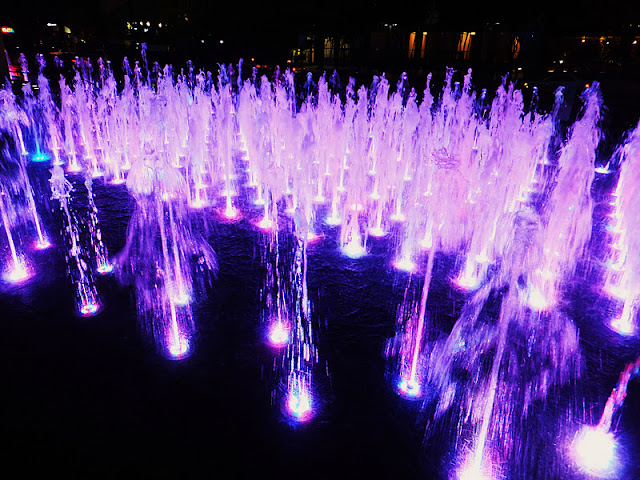I walked to Gwanghwamun Sqaure after a very satifying dinner at Gwanghwamun Jip 광화문집.
King Sejong, The Great
 |
| Armillary Spheres |
 |
| Sundials |
 |
| Rain guage |
 |
| Wish I understood these... |
 |
Leading to the subway station. Was this also known as the "Sunken Square" as stated in visitkorea? |
 |
| They brightened up the place ^^ |
 |
The statue of Admiral Yi I didn't read up about the history of Korea and had no idea about this statue. Just before I upload this post, I read about Admiral Yi from wikipedia and came to know that Admiral Yi is considered one of Korea's greatest heroes of all time. Koreans look upon Admiral Yi as a man of courage, perseverance, strength, self-sacrifice, intellect, and loyalty to his country. He was a charismatic leader, and was able to maintain his soldiers' morale despite constantly being low on supplies and food, and continuous news of countless Korean losses in ground battles. In some records, it is stated that he went as far as to personally fulfil some of his soldiers' dying wishes. He demonstrated his loyalty to the people by treating them with respect and fighting amongst them even when endangered. Because of this, Admiral Yi became immensely popular among his soldiers and the Korean people, who often provided him with intelligence reports at great risk to themselves. I teared when I read about Admiral Yi....I think he had a tough but honourable life. As extracted from wikipedia, Admiral Yi's last words, "나의 죽음을 알리지 마라"- The war is at its height -- wear my armor and beat my war drums. Do not announce my death.. He told his nephew to wear his armor and to hide his death until the battle is over to avoid demoralizing his men in the middle of battle. Hmm...I am so curious about the turtle ship, which Admiral Yi was famous for. |
 |
| Beautiful!! |
 |
| A cold but beautiful night for me ^^ |
 |
As extracted from asiasociety, "the most outstanding of King Sejong's achievements by far was the creation of hangul. Previously, scholars had learned classical Chinese and had relied on the Chinese script for literary purposes, but Koreans did not have an appropriate script for their spoken language. Until the invention of Hangul, they had used clumsy and cumbersome systems that made use of some Chinese characters for their pronunciation and others for their meaning to represent the vernacular language Whilet Chinese is a language very different form Korean in its vocal patterns and sentence formation, it could not represent Korean sounds and structure adequately. Besides, the complexity of Chinese characters made the writing system too difficult for those other than the few privileged to learn and master. King Sejong wanted to provide Koreans with a written means of expression other than the complicated Chinese system. With this objective in mind, he commissioned a group of scholars to devise a phonetic writing system that would correctly represent the sounds of spoken Korean and that could be easily learnt by all people. The system was completed in 1443. Initially, the use of Hangul was opposed by many scholars and government officials. They argued that use of Hangul would hinder education and government administration, both of which were dependent on the Chinese writing system. Despite this, however, King Sejong ordered popular poems, religious verses, and well-known proverbs to be translated into Hangul to encourage its use. Hangul was thus a political, in addition to a linguistic, achievement." |
Its no wonder there was a Hangul Day to mark the invention and the proclamation of hangul ^^
 |
| Story of King Sejong began .... |
 |
| King Sejong was born in 1397 |
 |
King Sejong passed away in 1450. I may be ignorant of many great things he did for his people but there was no doubt that he had done many things that brought about very positive impacts to Korea. |

 |
| Trinity of Life : 天,地,人 = 하늘, 땅, 사람 = Heaven, Earth, Humanity |


































No comments:
Post a Comment